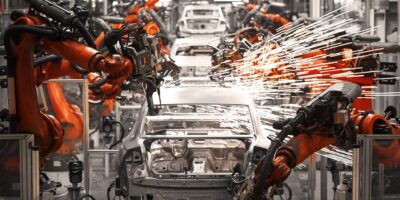The Labor Shortage Is Acute in Many Industries
Imagine you own a concrete-slab driveway. It’s solid and functional, but ugly and cracks more and more with each passing winter. With an eye toward making your driveway both more serviceable and aesthetically pleasing, you plan on replacing it in the spring with brick or cobblestone. You finally have the money to upgrade.
Toward that end, you make some design decisions, plan a budget, perhaps even stockpile some of the raw materials and tools that the project requires. And then, on the appointed date… nothing happens.
The missing input — labor — is either booked with other jobs far into the future or completely nonexistent. There are essentially no satisfactory substitutes. A desired finished good is therefore unrealized. Capital equipment and resources sit untransformed amid an utter scarcity of labor.
Bigger Scale
Now imagine that instead of a homeowner, you’re a construction company, an agricultural concern, or a manufacturing firm — all similarly unable to undertake infrastructure projects, fill freight trains with crops, or produce the countless scores of products the market seeks.
This is exactly the situation the United States finds itself in now. And it is worsening. Last year, the Associated General Contractors of America reported that 80 percent of its 27,000 member firms are having a difficult time filling openings for hourly craft workers.
The statistics are staggering in both their magnitude and breadth. By size, 79 percent of firms performing $50 million or less in work reported having trouble finding craft workers. On the other end of the spectrum, 82 percent of firms that performed $500 million or more in work indicated the same. The difficulties are, furthermore, being felt nationwide: 81 percent of contractors in the West and South, 80 percent in the Midwest, and 77 percent in the Northeast are reporting severe issues procuring labor; in 2017, those numbers ranged from 63 percent to 77 percent.
The outcome of this, of course, is two-pronged: as 47 percent of respondents to the Associated General Contractors of America poll noted, they are submitting higher bids for projects (so that they, in turn, can bid aggressively for labor that may be new to the workforce or leaving an existing job), while 46 percent also assert that the labor shortage is causing projects to take longer than projected.
Worst of all: some 66 percent of the respondents believe that tightness in the labor market will remain difficult or grow even worse in the next year.
And the crisis extends far beyond construction: in many subsectors of agriculture, home care, transportation, and manufacturing, the same phenomena are being reported. An estimated 8 million people, representing 5 percent of the entire U.S. workforce, are either fleeing or laying low. Each is reporting lower productivity, longer production times, higher explicit costs, and perhaps worst of all a massive explosion of forgone projects and skyrocketing opportunity costs. Consumers are receiving fewer goods and services at higher prices and at times at subpar standards.
No Documents, No Work
The ramping up of the longstanding (but until recently, mostly subdued) war on undocumented workers is, in short, an unmitigated commercial disaster. At the same time that American politicians on both the left and right are crowing about the need for a massive infrastructure overhaul, or jawboning support for the continuation and expansion of economic growth, policies that insert the government squarely between the private choices of employers and employees are thwarting the clearing of the labor market.
The labor shortage sends a cascade of unintended consequences rippling through producers and consumers alike. As things stand now, a massive infrastructure upgrade simply cannot happen. It will be like the driveway case above: no one actually to do the work.
Viewed another way, the distortive effect that unions and minimum wages have on the labor market are magnified into a complete dislocation by legal prohibition on the employer’s side and the fear of internment on the part of the undocumented employee.
It will only get worse. In construction, the number of additional workers needed will number close to 150,000 within five years; American citizens will not — barring a massive interventionist job program — amount for anywhere close to those totals. Undocumented immigrants also make up nearly one-quarter of all housekeepers and room cleaners, a workforce that will number over 110,000 within five years.
Finally, with baby boomers retiring in droves, the home care industry will require over 800,000 workers to fill a wide range of roles. Here, too, projections indicate that naturalized Americans will simply not meet the headcount requirements to accommodate seamless growth without jumps in price, changes in quality, and decreased availability.
It would be great for American workers to meet some portion of the labor undersupply, but doing so to any material extent is both unlikely and infeasible for two major reasons: the pervasiveness of workplace entitlements and sheer urgency. Long-standing government interference in employment markets, mostly in the form of minimum wage laws and union protections, make the majority of American laborers unwilling or unable to fill the current shortfall. Also, domestic workers are simply not as mobile and flexible as their undocumented counterparts.
The time it would take for the US government to eliminate the structural hindrances which make employing undocumented immigrants advantageous is an impracticable solution in the short term, and unlikely at any rate. Innovation may come in time, but not expeditiously enough to address the current labor force deficiency; nor is it clear that economic incentives are sufficient to attract entrepreneurs to this particular market opportunity.
The data alone tell the story no one wants to hear. Continued economic growth does not so much allow as require the inclusion — indeed the expansion — of the number of undocumented immigrants on American employment rolls.
Undocumented workers constitute a massive, often invisible, but critical component of the American labor force. Unlike most American laborers, they’re highly mobile — often season to season. They signal their dedication to productive work by undertaking the long, often-dangerous trip to the United States, only to live in relative obscurity with the fear of apprehension and the break-up of their families. Employers in many industries attest to their essential role in the success and viability of a range of enterprises.
It’s not only the driveway that doesn’t get constructed. It’s everything else too.











